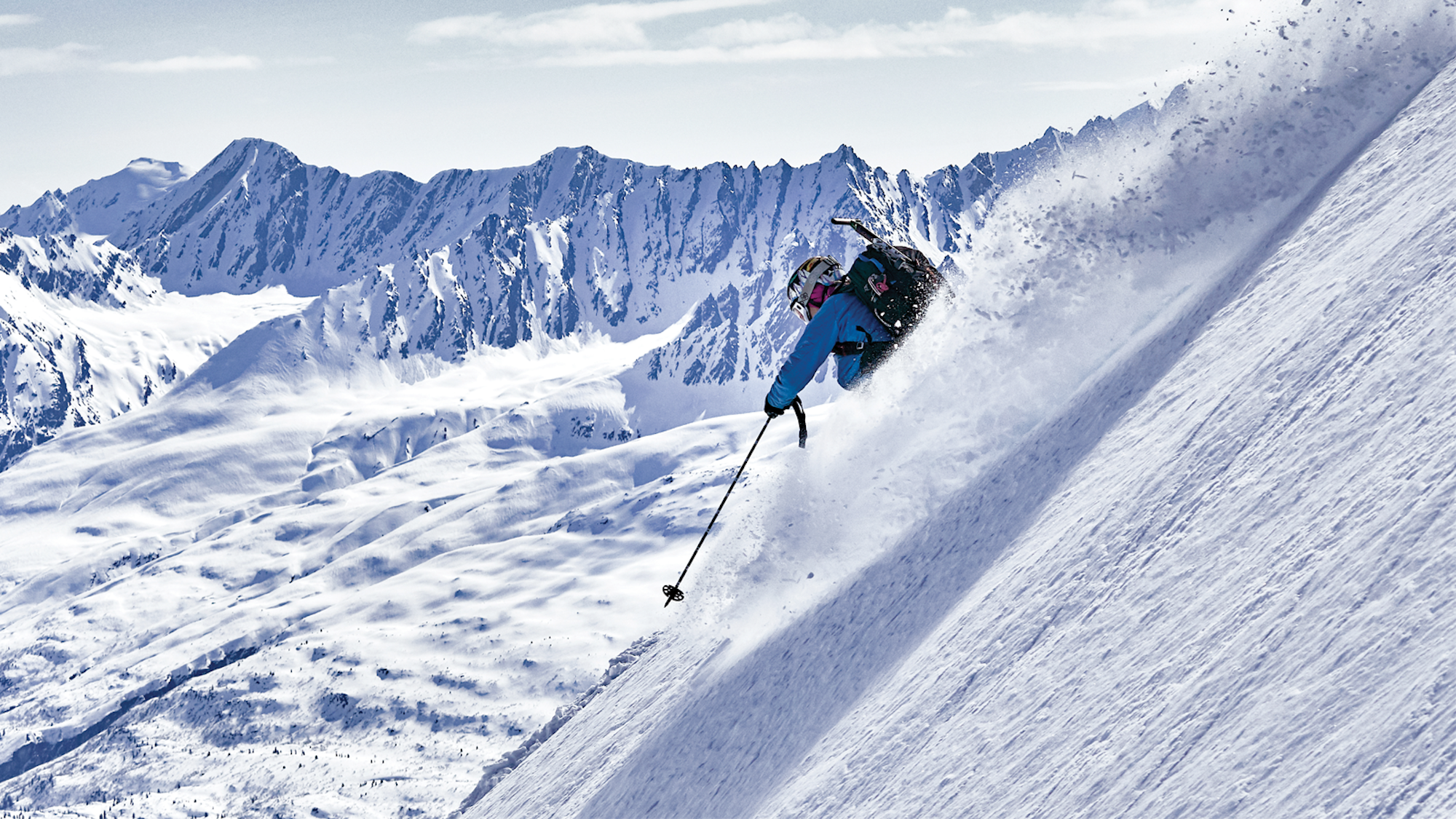WORDS — Jen Murphy
Here are stories of five ladies who span three generations and are proof that the mountains aren’t just a man’s world. Their tenacity to forge successful careers in a male-dominated space is inspiring a future generation of young women and redefining what it means to be a ski guide.

GNAR MOM — Kirstin Kremer
Kirstin Kremer just wants to ski the gnar. She’s been shredding gravity-defying lines in Alaska’s Chugach Mountain Range since 1993. Nearly three decades later, her excitement for these peaks hasn’t wavered. She intimately knows the intricacies of classic Chugach lines, like Meteorite and the Sphinx, and loves nothing more than sharing them with her clients at Valdez Heli-Ski Guides.
Most guides hop company to company to work their way up the ranks. Kremer, is one of the anomalies who has been guiding with the same operation for 25 years. Her secret: stubbornness and determination. The SoCal native spent her teenage years chasing extreme skiing pioneers like Shane McConkey, Aaron McGovern and Kevin Andrews around the slopes of Squaw Valley, now Palisades Tahoe. It wasn’t long before she was competing on Squaw’s freestyle team.
When her then boyfriend, Dean Conway, got invited to compete in the World Extreme Skiing Championships in Valdez, Alaska in the early 90s, Kremer tagged along and got hired as the event’s forerunner. “That was my first experience ever heli-skiing and I knew I had to figure out a way to do more of it,” she says. She tried the ski film route in Jackson Hole with Teton Gravity Research but didn’t like the pressure of “being rad” on demand. “I wasn’t good at that style of performing,” she says. “I got too nervous.”
Kremer returned to Alaska in 1997 determined to work for VHSG, a year-old heli-skiing operation started by two-time World Extreme Ski Champ Doug Coombs and his wife Emily. Back then, guiding certifications barely existed. Her resume included an EMT license, experience as a whitewater rafting guide and instructor at Alaska Mountaineering School and serious ski chops. “Every single day I’d ask if they had a job and they’d tell me no,” she recalls. She got hired as a waitress at Tsaina Lodge, VHSG’s unofficial clubhouse, and skied in her free time. She was entered in the Extreme Ski Championships that year and on day two of the competition, Emily Coombs called to say they needed a fueler. Kremer, 26, dropped out of the contest.
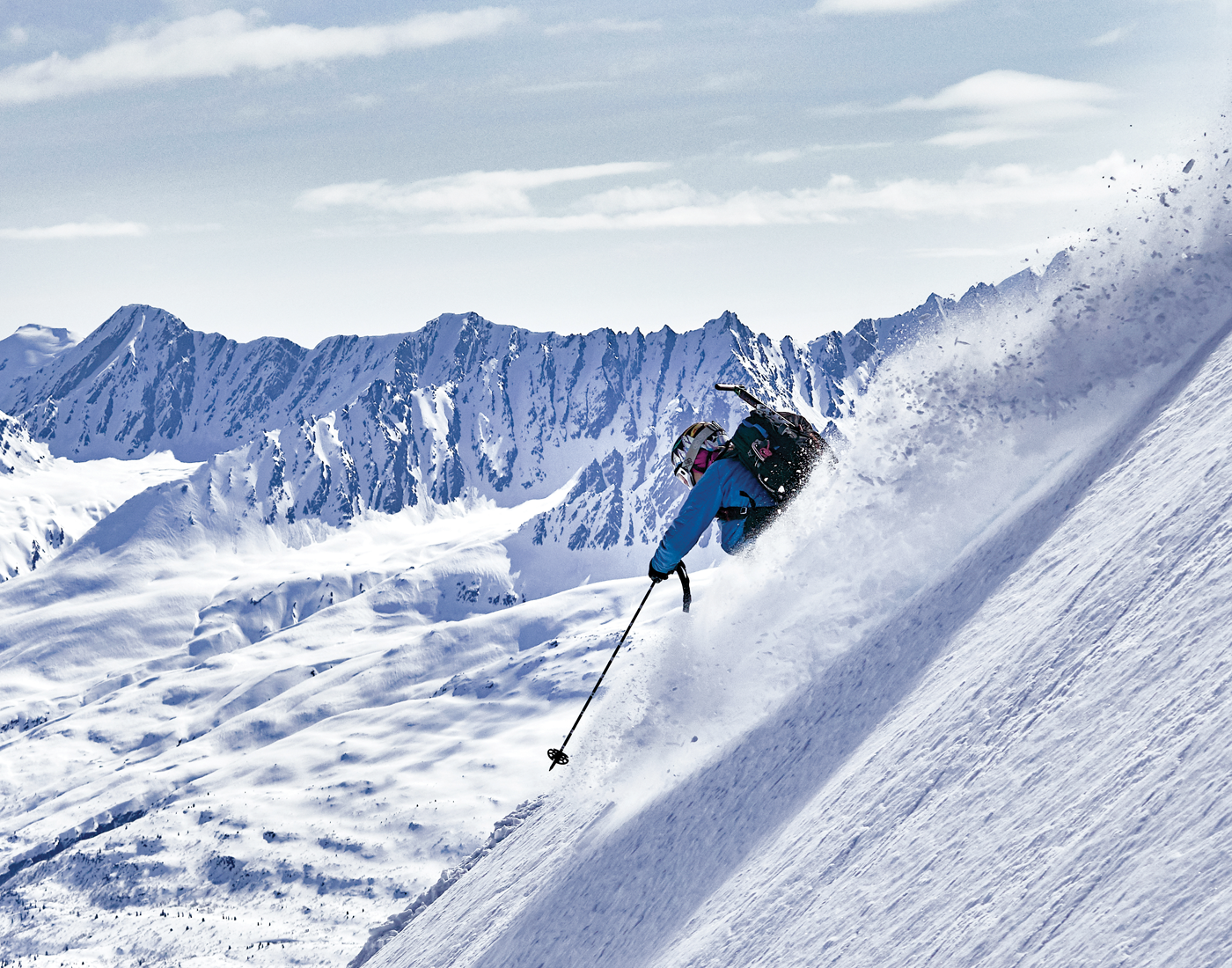
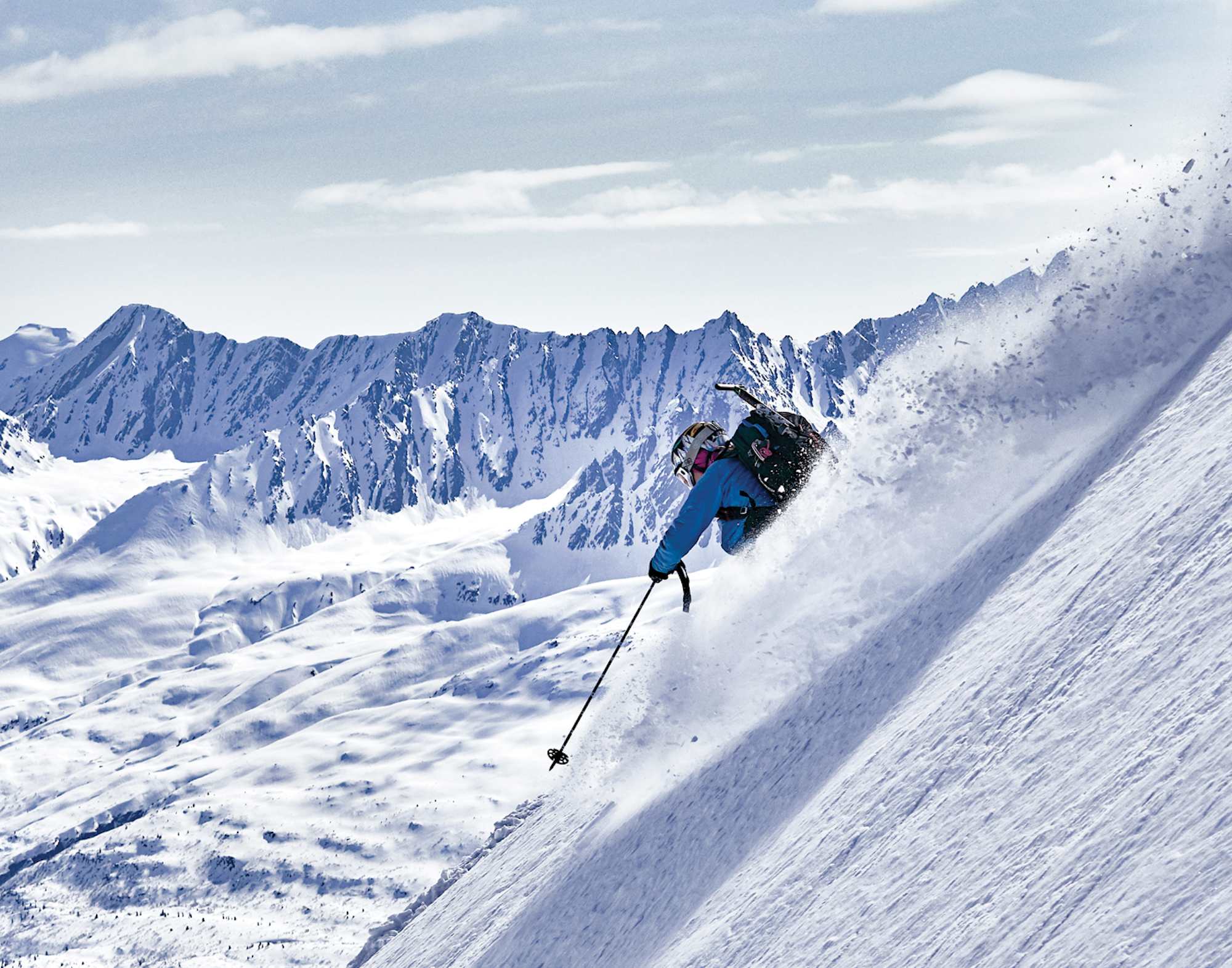
Fueling helis meant scrapping her waitress job and in turn, losing her housing. Undeterred, she bought a tent and pitched it in a ditch in the Tsaina parking lot. Fueling gave her the opportunity to tail guide whenever there was an extra seat. The next year she was promoted to dispatcher. “In the off-season, I basically stalked Doug and Emily,” admits Kremer. “I’d show up where they climbed to prove I had good rope skills. I desperately wanted to be part of their program. In life, you often get things by knowing people. I wanted them to know me.” By age 28, she was offered a guide position. “There were girls with more experience on their resumes, but Emily liked that I was so tenacious and saw I was trainable,” says Kremer.
“I also think she worried I wasn’t going to go away.”
Having Emily Coombs as a mentor bolstered Kremer’s confidence in a very male space, though, her husband, Tim Stephens, jokes she has more testosterone than most men. If clients question whether a pixieish, 5’4” Kremer could rescue them from a crevasse, she’ll start cranking out one-arm pull ups from the beams of Tsaina’s bar to silence their doubts. She has made grown men cry, scolding them for not following her instructions, but has also earned a loyal following for her ability to encourage and progress clients on terrain.
Over the years, she’s figured out how to make a living doing what she loves while still carving out time to pursue personal skiing and climbing trips. Kremer’s life philosophy is more is more. “The more we have, the more money and time we spend maintaining what we have,” she says. She’d rather duct tape her boots than be beholden to a sponsor who’d give her a free pair. Home is a 12×12 cabin without power or running water and during heli-season she “glamps” in a converted bus in the Tsaina parking lot. Her frugality has allowed her to choose the jobs she wants as opposed to having to work. “It gives me the freedom to travel on adventures and that’s the real richness of life,” says Kremer.

STAR OF HER SHOW — Amy David
Amy David loves the spotlight. And the Wyoming-native isn’t ashamed to shine it on herself to get others to pay attention. David has been skiing since she could walk. She stomped her first backflip in 8th grade rocking a bright pink jacket. As a young girl, she also loved pink nail polish, makeup and well, being girly. “It takes a while to realize some people find being girly and athletic at odds,” she says. Luckily, her generation had badass female role models. She credits skier Lynsey Dyer’s 2013 TEDx talk, Ski Like a Girl, with inspiring her to share her viral beauty queen big air video, Miss Wyoming Skis. David grew up in the foothills of Wyoming’s Wind River Range. When a pamphlet arrived in the mail for the 2009 Miss Teen USA Wyoming pageant, she borrowed a dress, bought earrings at Walmart and strapped on heels to practice her runway walk down a dirt road near her parents’ home.
It’s easy for naysayers to write off beauty pageants as vanity competitions, but when David, then 17, won the crown, she got access to communications and fitness coaches and learned the importance of sponsor relationships and public speaking. “A defining moment of winning that prize was learning to articulate goals,” she says. “At 17, I started saying out loud that I wanted to be a professional skier. I have fantasies of starring in a TGR film.” Five years later, TGR hadn’t called yet, so she made Miss Wyoming Skis and posted it on TGR. “At a certain point, you control your destiny,” she says.
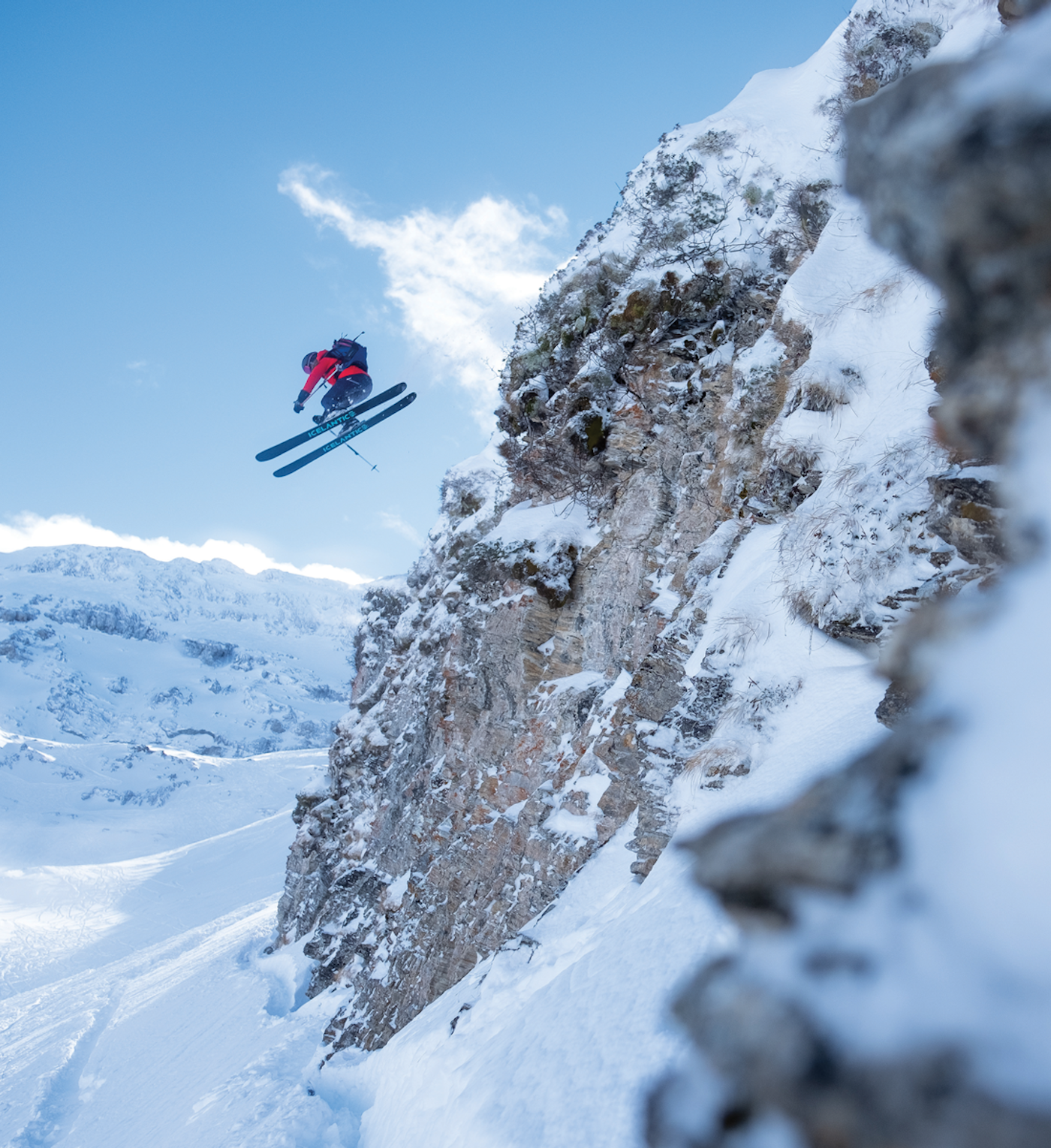
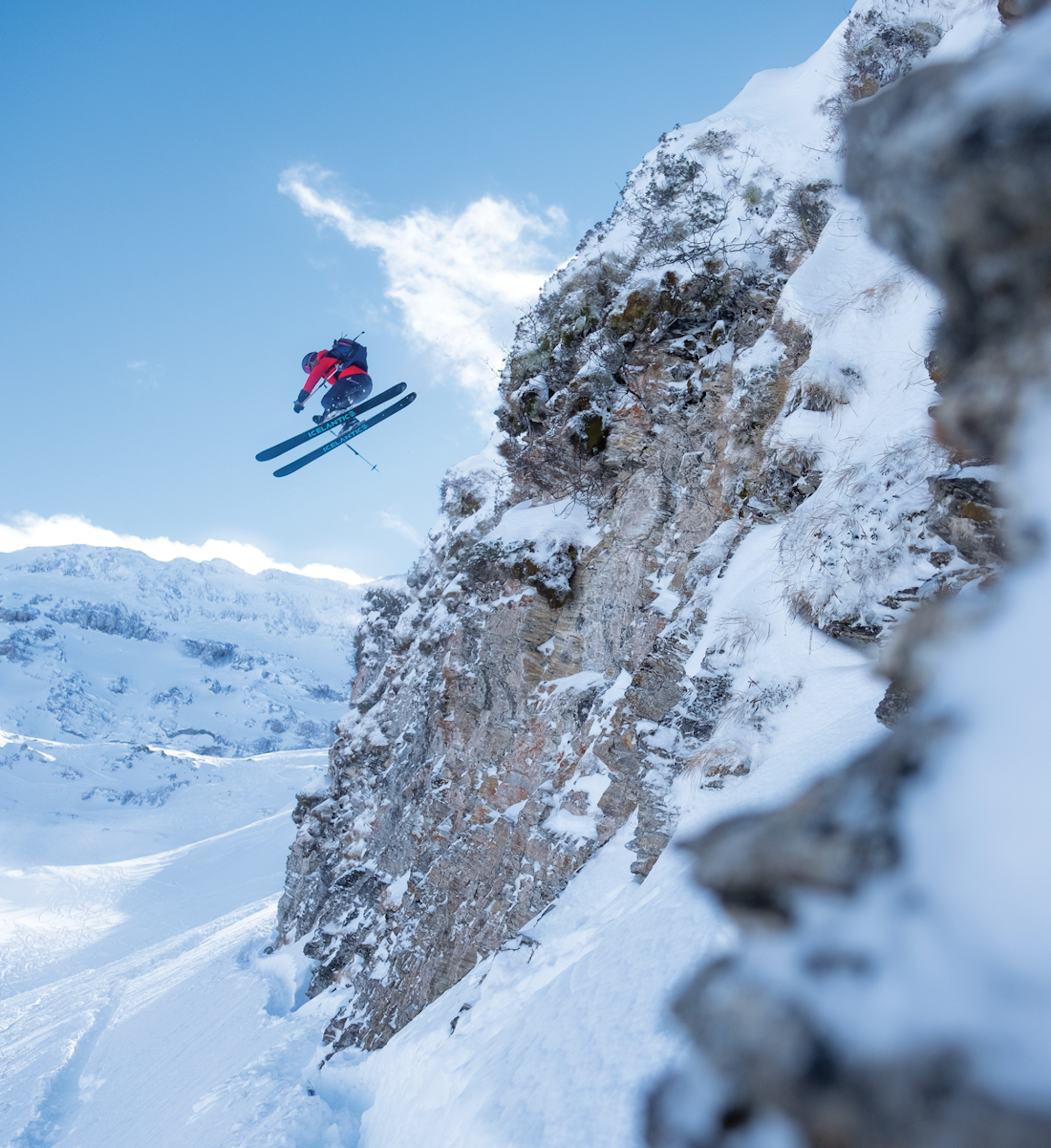
Early on, David realized a viable ski career required side hustles; ideally ones that could expand her knowledge and connections in the industry. Two weeks after she moved to Utah to attend college and pursue bigger mountains, she blew her ACL skiing. Her high school ski coach had always emphasized the need to build value beyond athletic ability. His lesson was driven home when she re-injured the same knee one year later. “I still wanted to chase my skiing dream but had to figure out how to do it when I couldn’t ski,” says David.
She quit her paid job for an unpaid internship with the Freeskiing World Tour and spent three years doing PR and working as an on-camera announcer. “It helped me in the long run because I learned how to pitch stories to media outlets, write press releases and get used to being in front of a camera and crowd,” she says. When she left the gig in 2016, she was ready to compete instead of play camera girl. David placed third as a wildcard in a freeride competition in Verbier. She went into the finals in Big Sky full of confidence, only to hit a roll in the terrain while straightlining a narrow chute. David launched 100 feet in the air, landed in a scree field and sustained a broken pelvis and ribs, strained C4 and a bruised lung.
The months of recovery gave her time to think about the nuances of earning a living while skiing. “I lived paycheck to paycheck in my early 20s,” she says. “I knew I had to layer my jobs in the industry if I wanted a sustainable career.” Her new strategy involves guiding, content creation and skiing as a sponsored athlete. She’s even thought about her retirement plan: an avalanche forecaster.
David now lives in Stanley, Idaho where she works as the media coordinator for the Friends of the Sawtooth Avalanche Center. She became certified as an AIARE avalanche instructor and is pursuing her American Mountain Guide Association ski guide certification. “Personally, I have the desire to ski big, dangerous lines in the backcountry,” she says. “But guiding and teaching others how to enjoy the backcountry has given my skiing more purpose.”
She hasn’t given up on landing a TGR cameo. If anything, she says her accident has made her a more technical skier. “Rather than just huck it I analyze the terrain and have a plan,” she says. Through her company, Action Inspired, she produces and stars in video content that she sells to clients like Ski Utah. And she’s been honing her tricks for the camera as an Icelantic Skis athlete. In 2018, she was invited on her first international shoot with the brand in Japan. “The filmmaker kept telling me there was no pressure to be fancy, I just needed to make pretty powder turns,” she says. “It really got under my skin. I was the first in our group to land a backflip and asked, ‘Is that pretty enough for you?’” I’ve learned to let my skiing do the talking, she says.

THE NEW FACE OF GUIDING — Johanna Stalnacke
Johanna Stalnacke is used to people doubting her. A pretty, blue-eyed, blonde-haired Swede, petite but powerful, she defies the bearded, gruff mountain guide stereotype. “I don’t look the part,” she says. “It’s been a hell of a journey to position myself in the mountain community.” Born in northern Sweden, Stalnacke was on skis by age three. Ski racing, gymnastics and sport climbing dominated her youth. A Nordic champion in bouldering and Swedish junior champion in sport climbing, it didn’t take long for her to gravitate to high alpine terrain first for climbing and soon after ski mountaineering. By her early 20s, she knew she wanted the mountains to be more than a hobby. She moved to Norway and finessed her leadership skills training the British Royal Marines elite mountain unit to ski. “People were always surprised when they met me,” she says. “After 10 minutes skiing with me I’d have their respect,” she says.
When she wasn’t working, she was charging hard in big mountain terrain, making headlines by bagging first descents like the Lambda couloir in Troms, Norway. Her love of steep skiing eventually led her to move to Chamonix, where fellow Swede and extreme skier Andreas Fransson took her under his wing. “I remember looking up at this classic run, Pas de Chevre, from town and telling Andreas I would really like to ski it,” she recalls. “And he laughed and said, ‘you’re going to ski it and when you do you won’t even think it’s a big run.’ He saw my motivation and potential much sooner than I did.”
Fransson was one of the few who encouraged her. Others, mostly men, thought her style was too aggressive. “When a woman is doing things on a high level that involve risk it’s a contrast for the general audience,” she says. “It’s easier for them to question if this is safe and responsible than to say go for it. It comes down to exposing their insecurities. As a woman, you’re a threat.”
When images of Stalnacke’s monster descents got featured in ski magazines, she should have been stoked. Instead, she faced backlash from traditionalists in the Scandinavian guiding community and was told to tone down her media coverage. Janteloven, an unspoken cultural norm in Scandi culture, discourages individual success or fame. As a result, Norway’s mountain community is much more conservative than anywhere else in Europe, she explains.
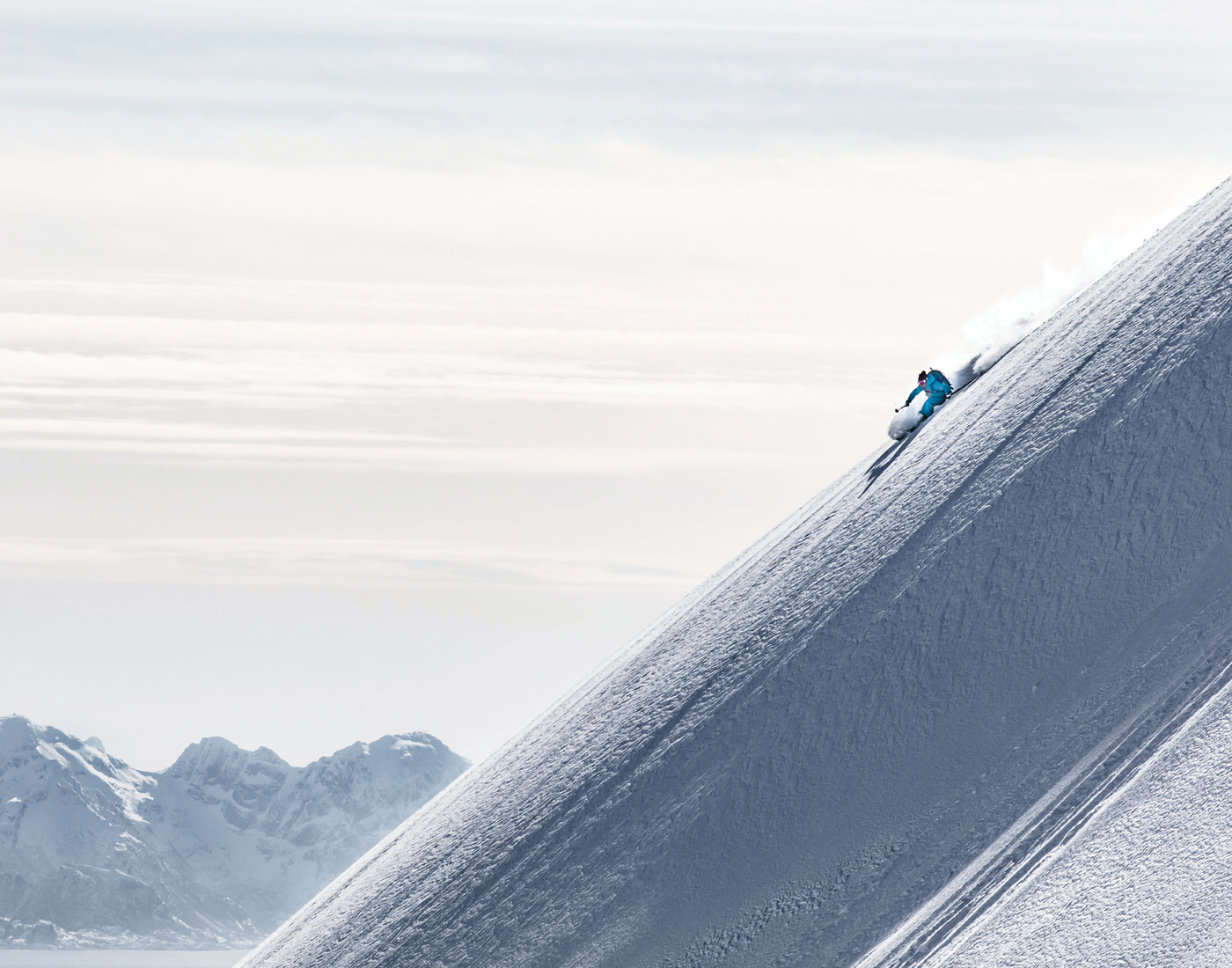
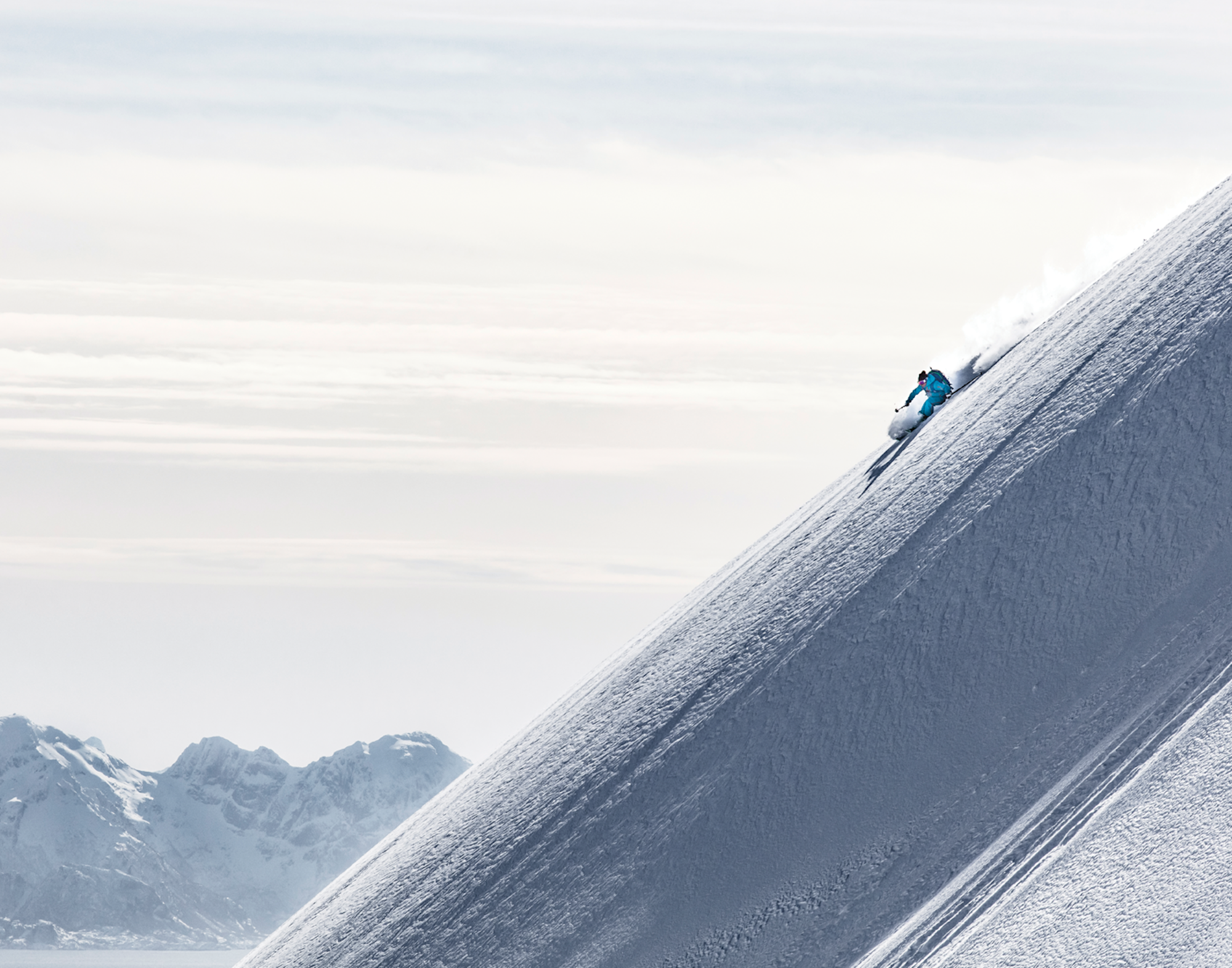
By 2015, Stalnacke had started her UIAGM mountain guide scheme in Norway. Men in the Norwegian guide community felt her freeskiing was at odds with her goal of becoming a guide. “I was told I wasn’t behaving like a mountain guide,” she says. “I would never take a client down a 55-degree face. But it’s my right as an athlete to pursue big objectives. It doesn’t mean I’m a bad guide.” In her final two years of the program, NORTIND, the Norwegian representative of the International Federation of Mountain Guides Associations, held meetings to discuss her relationship to risk. A report cited concern that she’d bring the culture of Chamonix to Norway. “I think I was provoking older people in the organization by skiing a lot better than them,” she says in hindsight.
In 2019, Stalnacke received her hard-earned IFMGA badge—the only internationally recognized credential that allows guides to work in any country worldwide. “Surely, my most meaningful gold medal and life achievement,” she posted on Facebook. The accomplishment allowed her to finally relax after years of pressure trying to prove herself. She doesn’t know if she could have completed the journey if she hadn’t started working with a mental performance coach in 2013, the year she failed her first IFMGA entry exam. “Our minds can help or destroy us,” she says. “Getting strong in my mind took my skiing to the next level and made me believe I would be a IFMGA guide.”

THE OTHER SIDE OF EXTREME — Brooke Edwards
Brooke Edwards measures an epic day in the mountains not by how many runs or how much vert her clients score, but by how many times they laugh. “For me, it’s not about the coolest lines, it’s about the stoke,” she says.
She ranks skiing with an 80-year-old named Howard among her best days ever while working with Chugach Powder Guides in Girdwood, Alaska. “We skied a flat 100 feet in the time the rest of the group did six laps,” she says. “We’d ski three turns, then look up at the mountains in awe. It’s the Howards of the world —the clients who cry because they’re so moved by the scenery—that make me want to guide.”
For years the exterior image of the heli-ski industry was intimidating. But Edwards didn’t subscribe to the extreme-skier-only notion. Her willingness to hang back with mellow skiers helped get her foot in the door at Chugach Powder Guides. Edwards was part of the sales team, but because of her background as a ski instructor at nearby Alyeska, she was frequently asked to ski the resort with the wives and girlfriends of male clients. “Most of them were bad-ass skiers but had been told by men they weren’t good enough,” she says. “I started my own crusade to convince more women to get in the heli.” Edwards ended up getting numerous unofficial tail guide days with some of Alaska’s best guides because she was game to ski intermediate terrain with nervous clients. She jokes her superpower is being a Jill of all trades rather than a rockstar at any one skill. Guiding isn’t about being the best climber, skier or alpinist, she says. It’s about being a great educator. No surprise, Edwards has a Masters-degree in education. A tomboy raised in the Pacific Northwest, she came to Alaska to pursue her avalanche education at the Alaska Avalanche School. Serendipitously one of the instructors was Scott Raynor, the new owner of Valdez Heli-Ski Guides. He offered Edwards an office job at VHSG the next season. “I never thought I wanted to be a heli-guide until I got to heli-ski for the first time,” she says. “As a woman, I don’t think I would have believed this could have been a path for me if it weren’t for Kirsten [Kremer]. She showed me that if you put in your time, show up and are willing to do the odd jobs you can break in.”
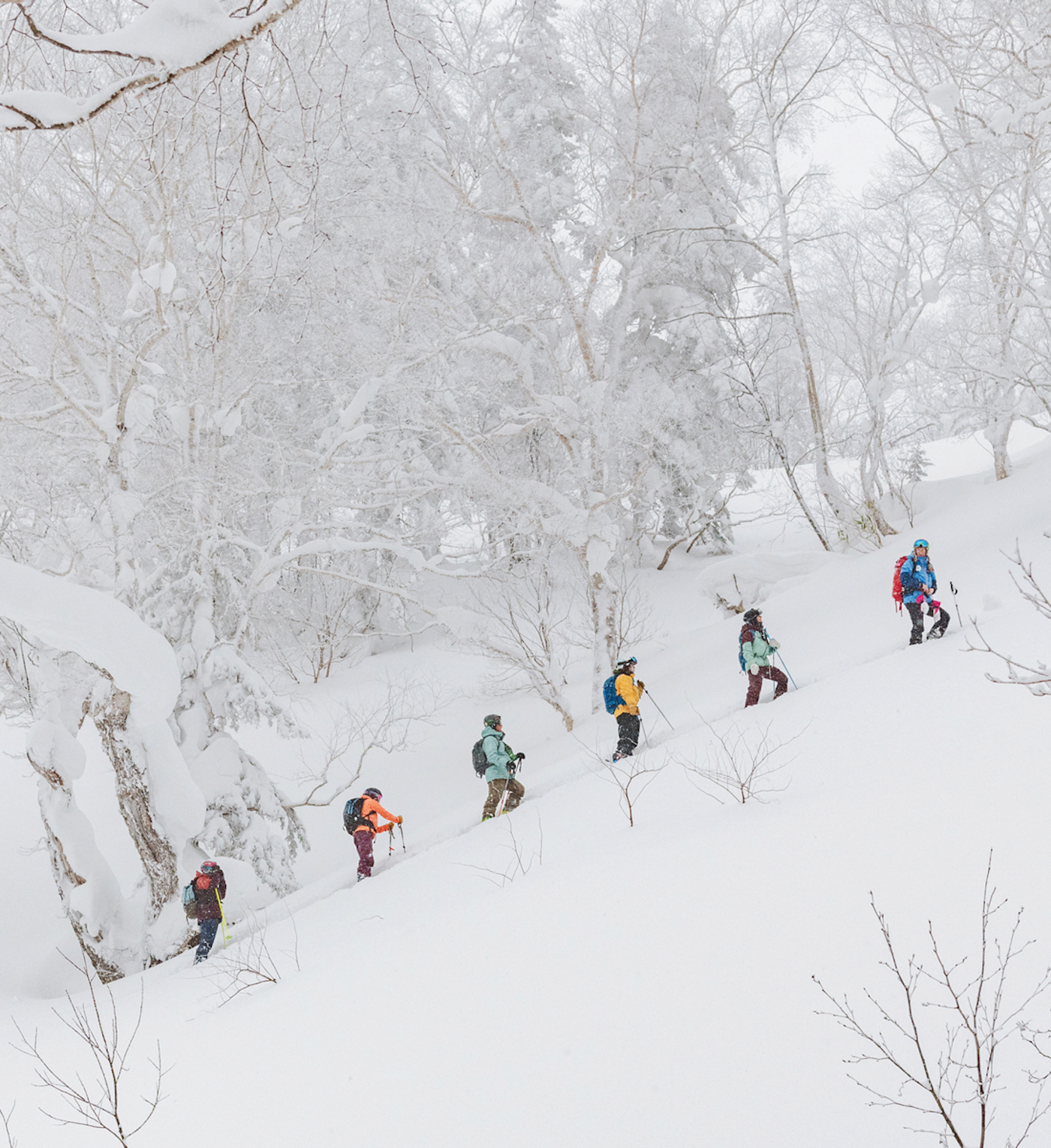
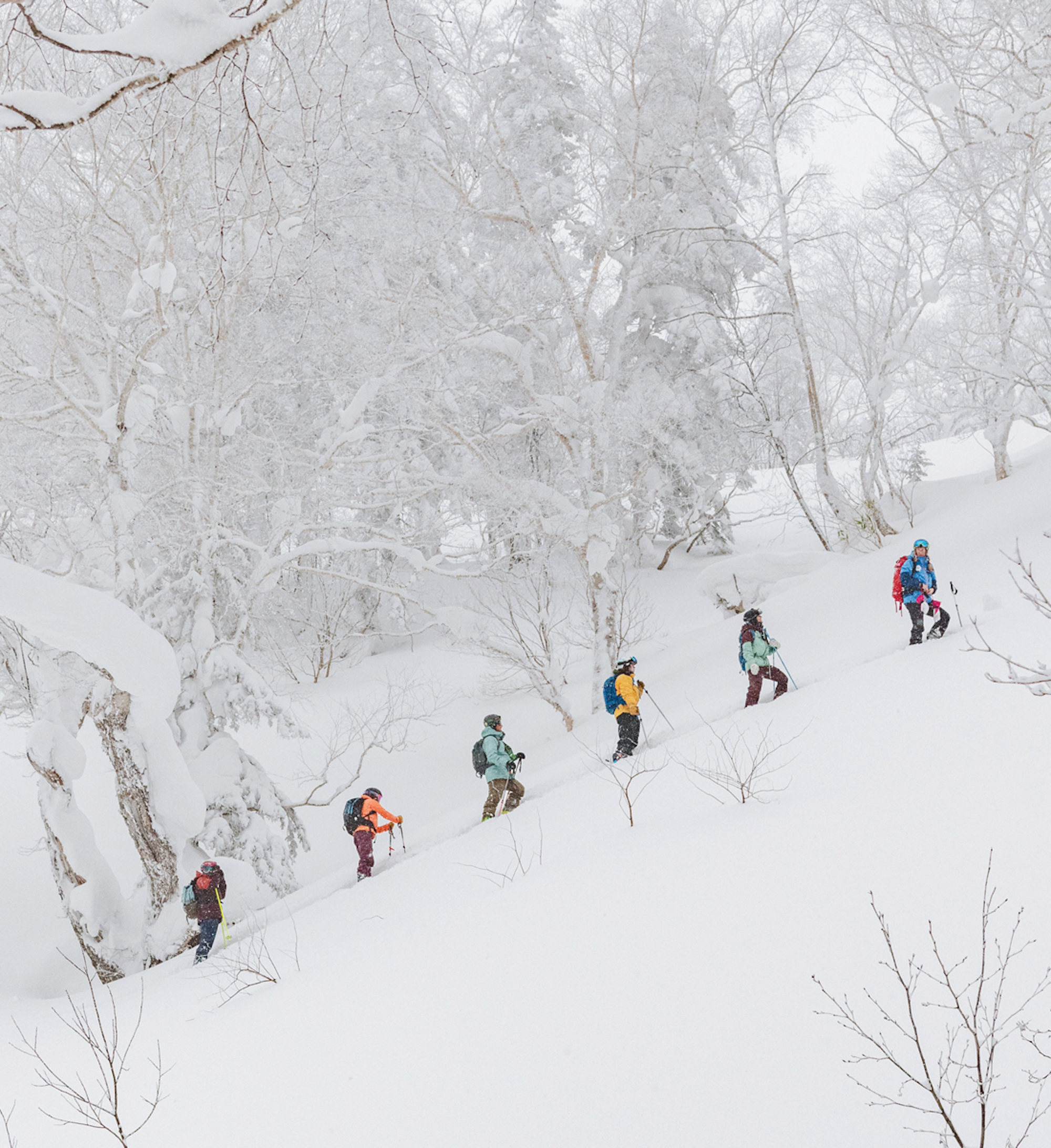
Two decades later, Edwards’ career landed her back at VHSG working alongside Kremer for the 2020-2021 season. “It was a turning point because I realized being a badass is about owning your own style,” says Edwards, a tall, blonde, who unapologetically wears make-up, bright-hued bell-bottoms and whose affinity for glitter earned her the nickname, Shiny. The path to being a heli-guide at one of Alaska’s most storied outfits has been lonely at times, she admits. There were years where she felt compelled to “dress like a dude” and battle to have a voice in meetings. “I like to think the young women coming up in the industry will be 100 times more confident than I was because there are more female role models,” she says.
Gender aside, making a living as a guide is a grind. When Edwards first moved to Girdwood in the late 1990s she worked as a substitute teacher, waitress, landscaper and ski instructor to afford her “hippie shack” dry cabin and bills. She relies on ambassador positions with brands like Atomic, Flylow, and Corbeaux to keep her outfitted with pricey gear. And as she ages, she worries more about injuries. She skied nearly the entire season in Valdez nursing a torn meniscus which required surgery this summer.
Clients always tell her, she’s living the dream, but sacrifices and choices have been made for that dream. “I’ve been living the seasonal life for 25 years, often not knowing where my next paycheck is coming from,” she says. “I don’t have a retirement fund, kids or a dog. But I still feel like I’m the wealthiest person on earth.”

COMPASSION COACH — Julia Niles
In her 20s, Julia Niles, like most young, aspiring guides, defined herself by her mountain feats: first ski descents, first alpine ascents, free solos. Now in her 40s, a mother of two kids, ages 8 and 11, she’s realized a great guide should be defined by so much more. A native New Yorker, she got her mountain grit from her grandfather. An avid skier with a cabin at Vermont’s Mad River Glen, he’d have a young Niles lap 20 top-to-bottom runs before 10 a.m. no matter the weather. Niles jokes she really wasn’t even that good at skiing but loved it anyway. “I never learned to turn,” she says. “My whole childhood I went straight down.”
At 19 she started alpine guiding, landing big mountain jobs on Denali and Chimborazo in Ecuador. “I was working for the American Alpine Institute making $72 a day with five people on my rope dropping people into crevasses and I couldn’t imagine doing anything else,” she recalls. “There was never a question about whether I’d become an all-around mountain guide.”
In 2009, Niles became the fifth American woman to attain the International Federation of Mountain Guides certification, having earned her ski guiding chops with Jackson Hole Mountain Guides. The journey had its share of hurdles, including a lung cancer diagnosis which required the removal of half of her left lung in 2006. To say FU to cancer and prove her toughness, she tackled Wyoming’s Grand Traverse just six months later, becoming the first woman to free-solo the 10-peak Teton route in a day. In those early years, fear and weakness were not options, especially as a female guide.
“The industry is very sexist,” she says. “Male clients assume you are the assistant. They refuse to listen to you. A male colleague says exactly what you just said, and everyone listens. Whenever I was unsure, I would project confidence, which is a very male coping mechanism. But it allowed me to command leadership in situations with guests.” Men weren’t the only ones making it hard for female guides. Sometimes women are their own worst enemies, seeing each other as competition rather than colleagues, notes Niles.
Older and wiser, with less to prove, she’s now on a mission to make the mountain community a more compassionate, inviting space. She mentors other girls and women whenever the opportunity arises and is trying to encourage a guiding community that values empathy and collaboration just as much as scoring sick powder lines. Pursuing her master’s degree in clinical counseling, she’s realized the industry needs more outlets to talk about realities like PTSD, loss, motherhood, and depression. Niles, like many in the industry, has had friends commit suicide and die in avalanches. When a friend and fellow mother died in an avalanche in Whistler in 2018 on a run Niles skied six times that season, it really hit home for her. Women are told they can have it all, but Niles is the first to admit, it’s hard.
Recently divorced, she says her low guide wages don’t justify a babysitter. Luckily, her mother helps watch the kids and unlike in the States, she gets free healthcare in Canada. “Becoming a mother changed my relationship with risk,” she says. “You need a clear head guiding. Sick kids might keep me up all night when I have to heli-ski 30,000 feet the next day, and not for much money. You have to ask sometimes, is it worth it?” The answer for her, is still yes, though these days she picks and chooses her guiding gigs carefully, whittling her hours down to 20 a week, and considers her guide days, rec days. “I don’t do it for money, I do it for my soul,” she says. “As mothers we can lose ourselves to the needs of our kids. My kids will always come first but being in the mountains is where I find myself. I know my kids will do better if I’m a happy person so I’m figuring out the juggling act and want other women to know they can too.”
Skiing is a sport that requires financial resources, especially if you want to pursue a guiding career. Bozeman, Montana non-profit Women of Winter recently launched a scholarship program that encourages BIPOC women to pursue guiding careers and provides education, training and gear. Find out more: womenofwinter.net

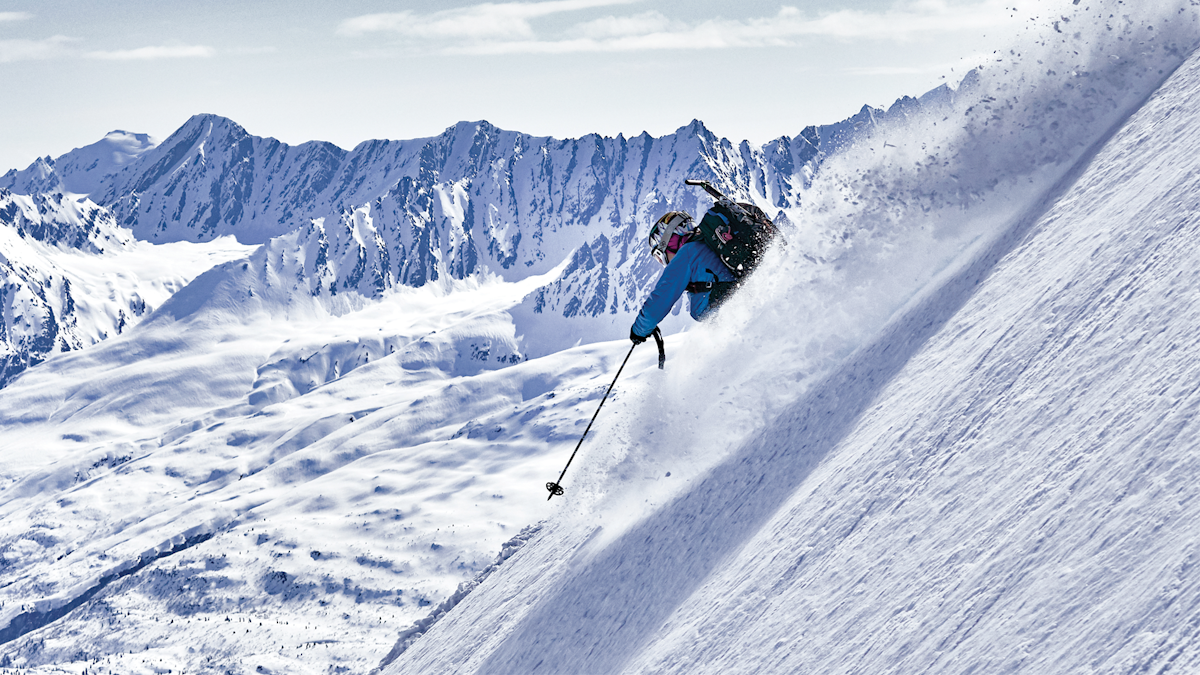

![[GIVEAWAY] Win a Head-to-Toe Ski Setup from IFSA](https://www.datocms-assets.com/163516/1765920344-ifsa.jpg?w=200&h=200&fit=crop)


![[GIVEAWAY] Win a Legendary Ski Trip with Icelantic's Road to the Rocks](https://www.datocms-assets.com/163516/1765233064-r2r26_freeskier_leaderboard1.jpg?auto=format&w=400&h=300&fit=crop&crop=faces,entropy)




![[GIVEAWAY] Win a Head-to-Toe Ski Setup from IFSA](https://www.datocms-assets.com/163516/1765920344-ifsa.jpg?auto=format&w=400&h=300&fit=crop&crop=faces,entropy)


